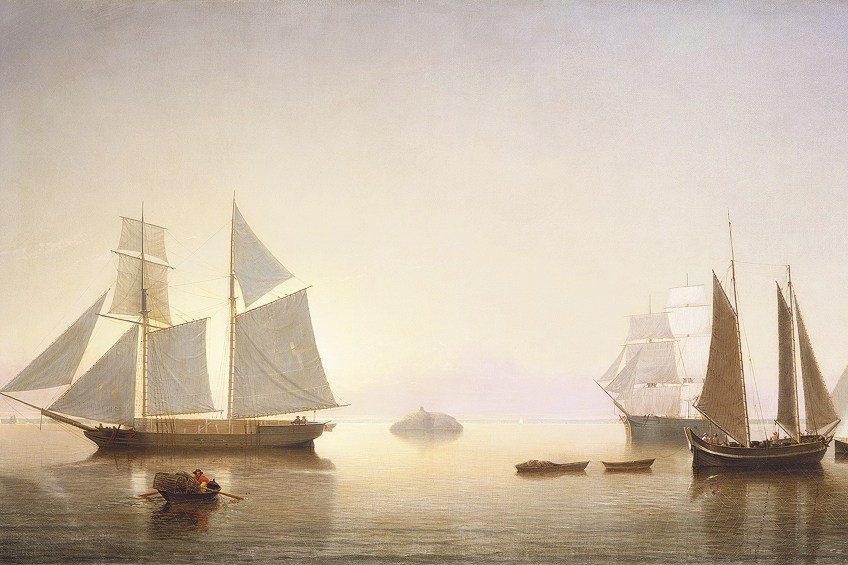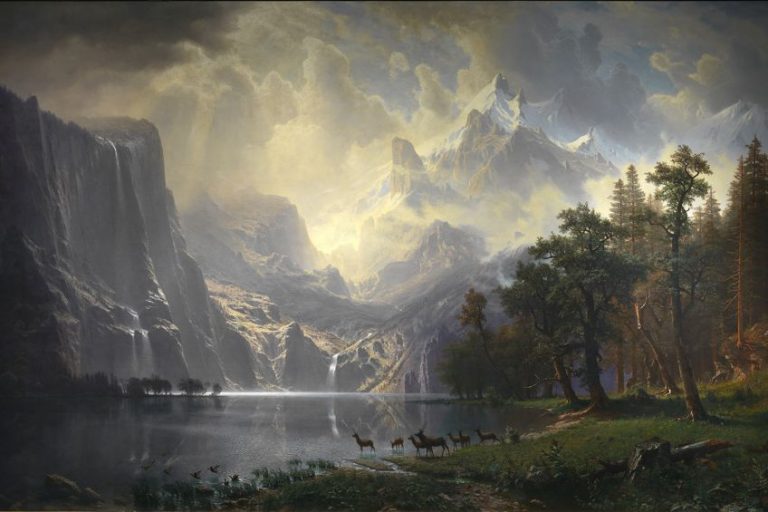Famous Ship Paintings – Best Nautical Paintings of Ships at Sea
Paintings of ships at sea are among the iconic artworks in the world. For centuries, numerous civilizations ruled the world’s waters, sending commercial vessels and ships of war out into the blue horizon; as a result, marine art emerged to depict these adventures and battles. Today, we will celebrate these famous ship paintings and boat paintings by giving them a deeper look.
Our Favorite Famous Ship Paintings
Nautical paintings commemorate the incredible vessels that once sailed the seas, as well as more subdued sailboat paintings. Over time, these vessels became the lifeline of the economies of nations such as the United Kingdom and Portugal, with their sailors carrying and delivering valuable goods of various types. For over a thousand years, ships of diverse kinds and sizes have sailed the oceans.
Part of what inspires the adoration of so many art lovers and aficionados, especially in coastal areas, is the contrast between brilliant man-made ships and the unpredictability and dangers of the ocean and Mother Nature herself.
Many painters have experimented with creating nautical paintings and their legendary sea excursions throughout history, with others specializing entirely in the theme of nautical travel. Here are our favorite paintings of ships at sea.
The Storm on the Sea of Galilee (1633) by Rembrandt
| Artist | Rembrandt van Rijn (1606 – 1669) |
| Date Completed | 1633 |
| Medium | Oil on canvas |
| Dimensions (cm) | 160 x 128 |
| Location | Stolen |
This well-known marine artwork was looted in 1990 from the Isabella Stewart Gardner Museum. The boat painting’s whereabouts are still unknown, and it might never be found again. However, there is some debate around the work. It has been the focus of various theft-related investigations ever since it vanished. During the 1630s, just as Rembrandt arrived in Amsterdam to start his professional career, he created what many believe to be his most dramatic works.
This artwork is an example of this period. Rembrandt picked a Bible narrative to demonstrate the seriousness of his creative ambitions.
Rembrandt moved to Amsterdam with the intention of being recognized for his historical artworks and portraits. Using a New Testament narrative, he illustrated how to blend a historical picture with a seascape. This New Testament incident would have been recognizable to Rembrandt’s contemporaries and, more than likely, admired by them. The suspense produced in the picture, on the other hand, would present the narrative with a totally new and surprising interpretation. This example of innovation and risk-taking by Rembrandt, then 27 years old, set him apart from his colleagues and became the foundation of his creative growth.
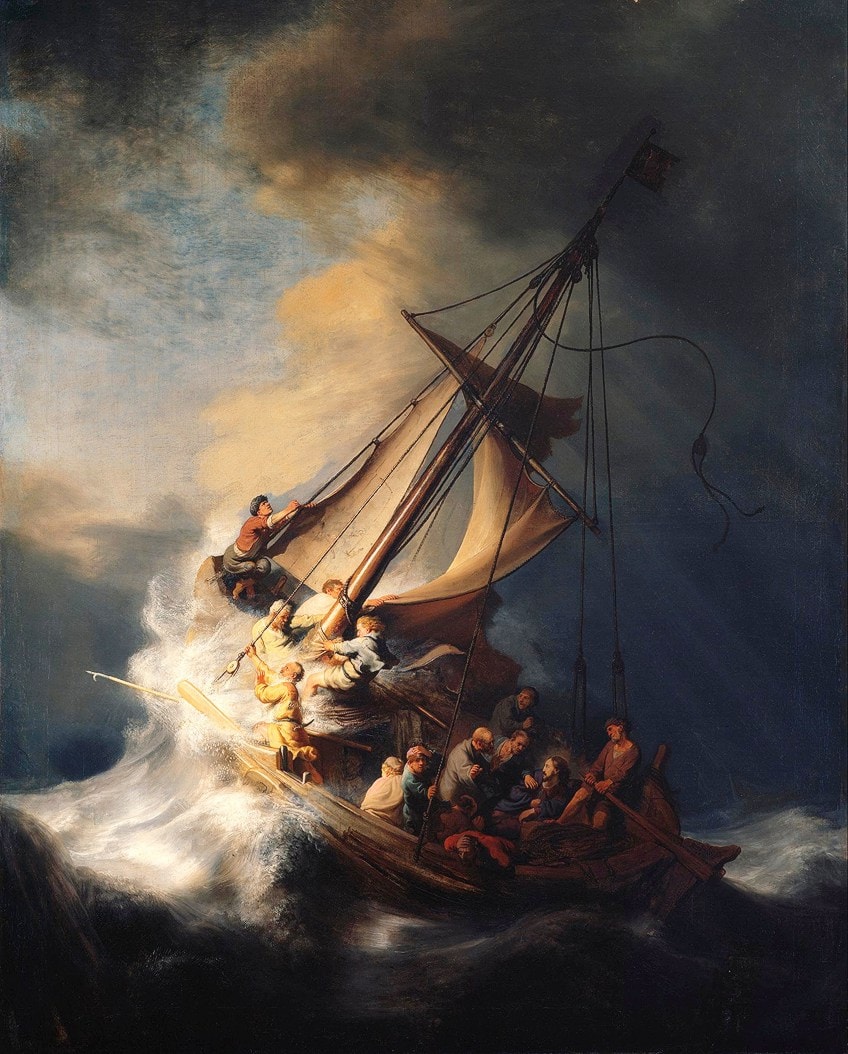
The Home Fleet Saluting the State Barge (1650) by Jan van de Cappelle
| Artist | Jan van de Cappelle (1624 – 1679) |
| Date Completed | 1650 |
| Medium | Oil on panel |
| Dimensions (cm) | 64 x 92.5 |
| Location | Rijksmuseum, Amsterdam, Netherlands |
As numerous pilgrims and travelers journeyed to the New World across the Atlantic Ocean in the mid-1600s, seafaring transportation was responsible for shaping the world’s individuals and nations. In his 1650 marine artwork, Jan van de Cappelle caught one significant event from this time period. The picture portrays a variety of ships gathered in a port to honor a major vessel as it set off on its trip.
Cappelle’s artwork is considered among the most famous ship paintings because he captures the water’s capacity to reflect events above its surface in exquisite clarity.
Jan van de Cappelle was a painter of winter landscapes and paintings of ships at sea from the Dutch Golden Age, as well as an entrepreneur and art collector. He is widely regarded as the greatest marine artist of 17th-century Holland.
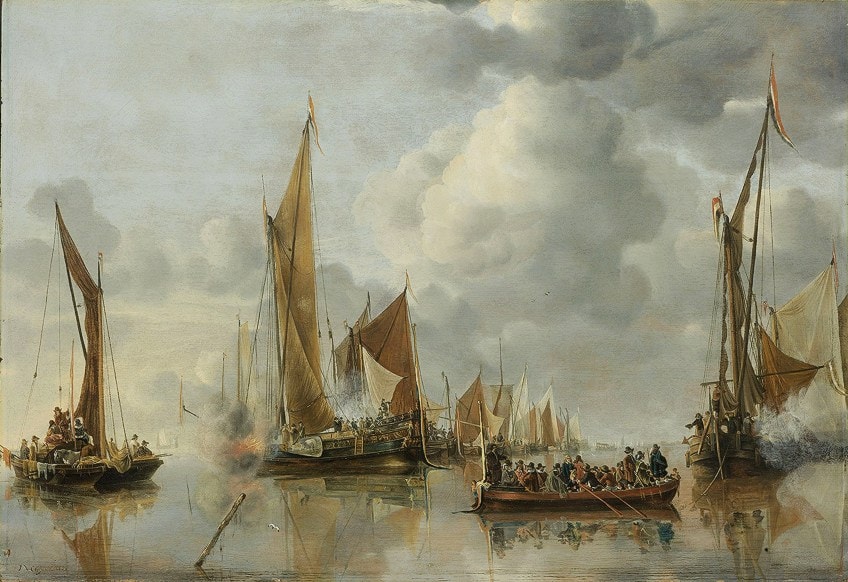
Nelson’s Inshore Blockading Squadron at Cadiz (1797) by Thomas Buttersworth
| Artist | Thomas Buttersworth (1768 – 1842) |
| Date Completed | 1797 |
| Medium | Oil painting |
| Dimensions (cm) | 63.5 x 99 |
| Location | National Maritime Museum, London |
During the second part of the 18th century, the British Royal Navy was at the pinnacle of its nautical power throughout most of Europe and the rest of the world. During this period, the nation’s formidable navy fought in several conflicts off the coast of Portugal as the two countries competed for supremacy of the waterways around coastal Europe and other regions of the Atlantic. In 1797, Thomas Buttersworth produced this picture commemorating a decisive naval fight for British forces off the coastline of Portugal.
Following the historic Battle of St. Vincent, Nelson and ten bargemen were conducting a night attack against Spanish gunboats.
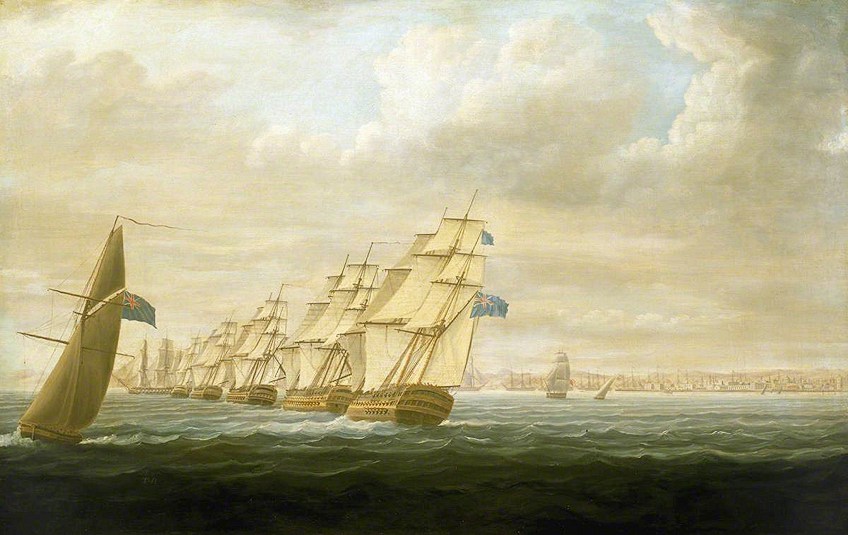
Battle of Trafalgar (1805) by Louis Philippe Crepin
| Artist | Louis Phillipe Crepin (1772 – 1851) |
| Date Completed | 1805 |
| Medium | Oil on canvas |
| Dimensions (cm) | 90.93 x 80.78 |
| Location | National Maritime Museum, Greenwich, London |
A number of the most famous ship paintings depict bloody sea conflicts between formidable naval forces. This is true of Louis Phillipe Crepin’s 1805 work. This picture shows one of the most well-known naval battles, which occurred in the year the artwork was made. The fight faced the formidable British Royal Navy against two other worthy adversaries—the French and Spanish naval forces—who had collaborated to try to overthrow the overwhelming force that had controlled the waterways surrounding Europe and most of the world at the time.
Crepin’s picture depicts the close-quarters warfare that was common in naval conflicts with exceptional precision.
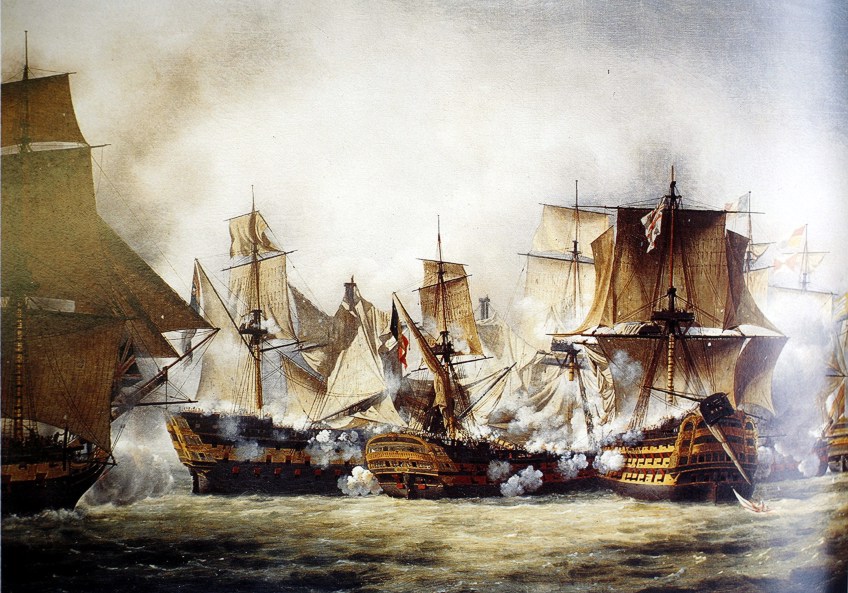
A First Rate Man-of-War Driven Onto a Reef of Rocks, Floundering in a Gale (1826) by George Philip Reinagle
| Artist | George Philip Reinagle (1802 – 1835) |
| Date Completed | 1826 |
| Medium | Oil on canvas |
| Dimensions (cm) | 102 x 127.2 |
| Location | Royal Albert Memorial Museum, Exeter |
The early 1800s were most likely the peak of the legendary ship painting era. George Philip Reinagle was a well-known marine artist noted for his ability to portray the character of the sea’s often violent nature that has wrecked so many big, strong ships throughout history.
His 1826 masterpiece is adequately titled since it depicts a ship caught in the grasp of the surging sea.
One of the most exciting features of maritime travel was the risk that mariners may perish if caught in a raging storm, sometimes known as a gale. This work is famous for Reinagle’s ability to capture the massive, crushing power of the waves, as well as the sea spray whipped up by the fierce winds. This piece serves as a sobering reminder that not all marine exploration and adventure are safe.
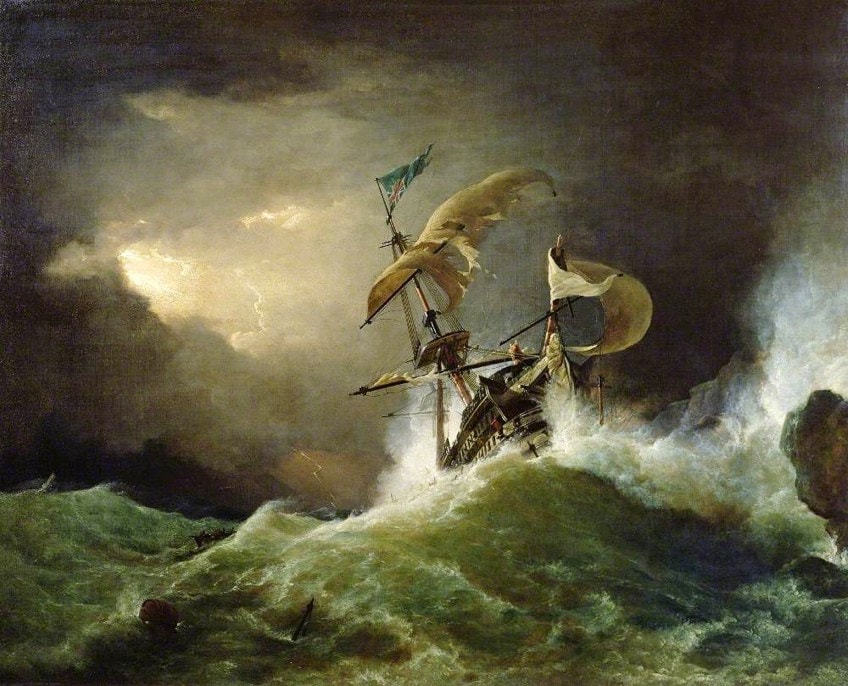
The Fighting Temeraire (1839) by J. M. W. Turner
| Artist | J. M. W. Turner (1775 – 1851) |
| Date Completed | 1839 |
| Medium | Oil paint |
| Dimensions (cm) | 90.7 x 121.6 |
| Location | National Gallery, London |
The early industrial revolution is suggested by the marine artwork’s surroundings. Even though the sky is illuminated, a tugboat is rushing to assist. The tugboat stands for the new era of steam, coal, and fire. Turner’s own emotions and imagination are revealed in the image, which is intriguing and romantic. Although it is difficult to determine the painting’s message, it is unquestionably an important symbol of its time.
Turner’s boat painting features opposing hues that give it a magical or ethereal appearance. In contrast to the gloomy sky, the tugboat pops out.
A little portion of the painting’s bottom is taken up by the water, striking a balance between the sky and water. The Fighting Temeraire, while not well-liked in its day, has grown in popularity over time. A significant character in British art history, John Ruskin, spoke favorably of the piece. Although the artwork was eventually taken off the auction board, many reviewers, including Turner himself, praised it as a masterpiece. Nevertheless, Turner kept promoting his work despite the numerous unfavorable reviews.
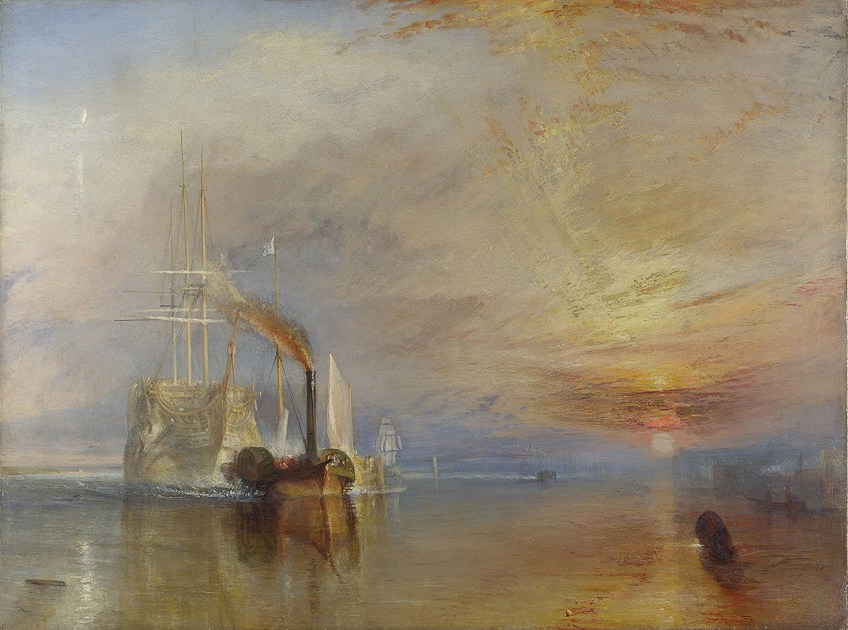
Becalmed off Halfway Rock (1860) by Fitz Hugh Lane
| Artist | Fitz Hugh Lane (1804 – 1865) |
| Date Completed | 1860 |
| Medium | Oil on canvas |
| Dimensions (cm) | 70.4 x 120.5 |
| Location | National Gallery of Art, Washington, DC |
Several of the most famous ship paintings ever made depict warships engaged in furious conflicts or stuck in tremendous gales on the wide sea. There are, though, a few significant nautical paintings that reflect the placid, quiet character of the ocean or coastal regions. This piece portrays ships tied around Halfway Rock, a prominent maritime landmark located roughly halfway between Cape Ann and Boston.
This place was a popular stopping point for commercial vessels and supply ships since it allowed them to connect with other ships and conduct many forms of maritime commerce at a precise spot.
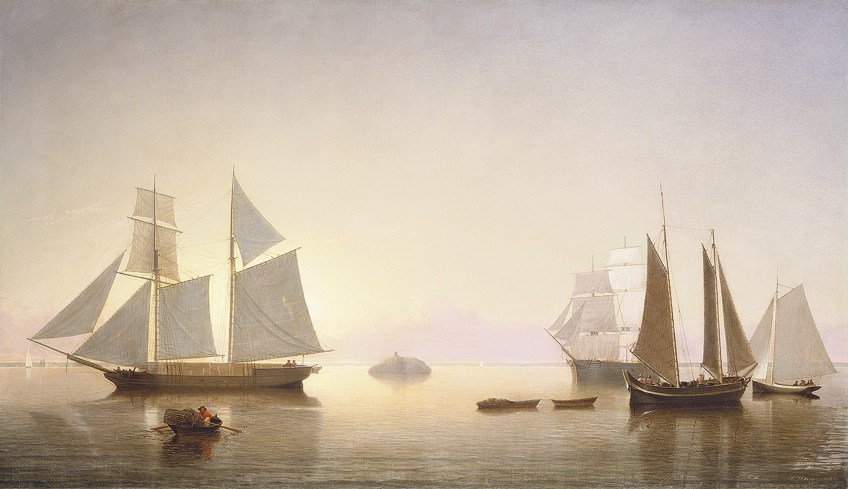
Red Boats, Argenteuil (1875) by Claude Monet
| Artist | Claude Monet (1840 – 1926) |
| Date Completed | 1875 |
| Medium | Oil painting |
| Dimensions (cm) | 61.8 x 82.5 |
| Location | Musée d’Orsay, Paris, France |
Monet depicted the town and outlying areas of Argenteuil during the 1870s, creating images of harmony and beauty that were sometimes at odds with the realities of the time. Despite his belief in en Plein air painting, Monet painstakingly selected the components he wanted to incorporate and often completed his works in the studio.
His works include no hints of the contamination of the river at Argenteuil or the chaos of a community pushing all into its industry.
Monet created the composition in this painting by using boats, particularly the verticals of the masts. Again, he used contrasting colors in the form of oranges, blues, greens, and reds. The painting is vibrant with color, and the blues and purples depict the depth of the sea.
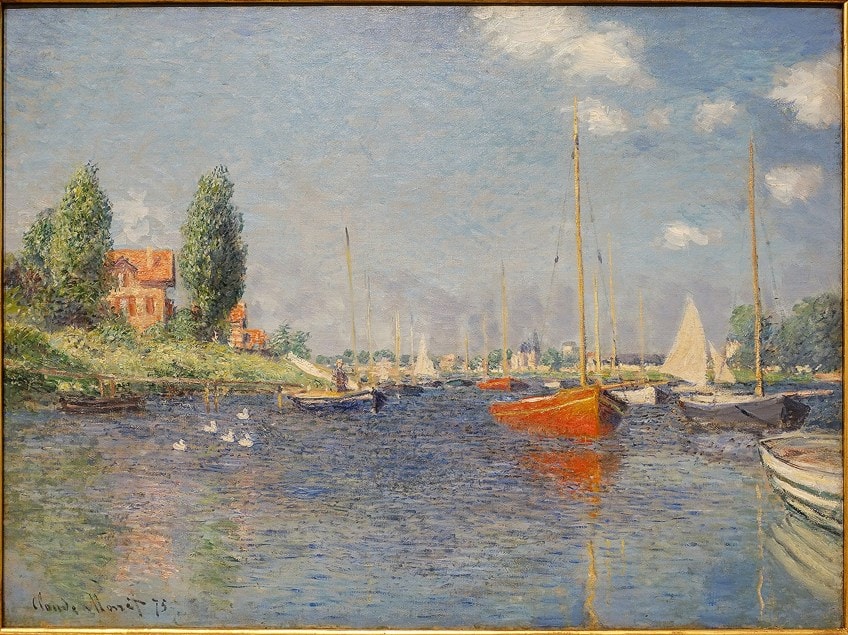
Breezing Up (A Fair Wind) (1876) by Winslow Homer
| Artist | Winslow Homer (1836 – 1910) |
| Date Completed | 1876 |
| Medium | Oil on canvas |
| Dimensions (cm) | 61.5 x 97 |
| Location | National Gallery of Art, Washington, DC |
After visiting Massachusetts, where he first painted in watercolor, Homer started this painting in New York in 1873. He utilized the sketches he made there to create an oil painting that he worked on for three years. Infrared reflectography has shown the several composition modifications he made during this period, including the erasure of a fourth youngster near the mast and a second ship in the distance.
The artwork’s theme is upbeat; despite the turbulent seas, the boaters appear to be at ease. The anchor that substituted the person in the bow was said to represent hope.
The youngster at the helm looks to the horizon, an expression of hope for his and the nascent United States’ future. The final piece demonstrates that Homer was influenced by the substantial impact of Japanese art on Western artists in the 19th century, notably in the compositional balance between the dynamic and sparse parts. In 1866, Homer visited France, and the influence of French artists Claude Monet and Gustave Courbet’s nautical paintings is also visible.
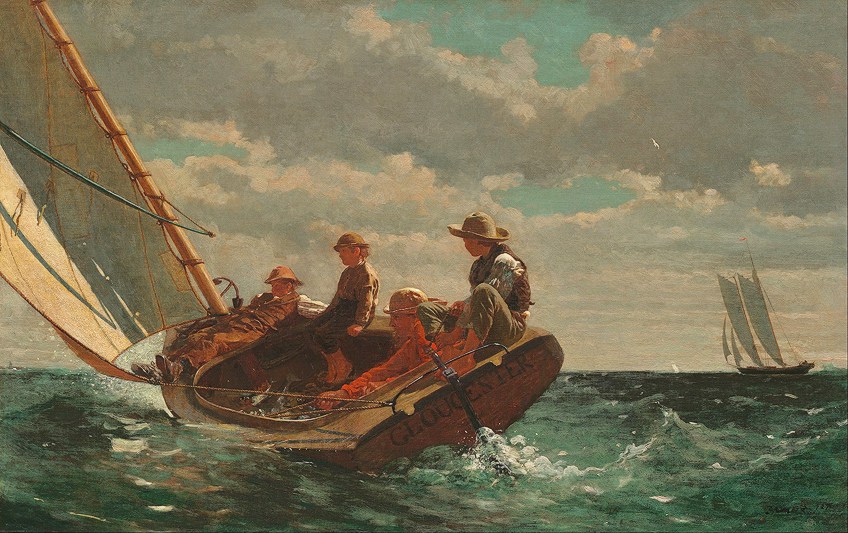
Fishing Boats on the Beach at Saintes-Maries (1888) by Vincent van Gogh
| Artist | Vincent van Gogh (1853 – 1890) |
| Date Completed | 1888 |
| Medium | Oil on canvas |
| Dimensions (cm) | 39.5 x 53.3 |
| Location | Van Gogh Museum, Amsterdam |
This sailboat painting is a reworking of the artist’s drawing and is one of his most impressive attempts at establishing balance and harmony. The fishing boats stand in sharp contrast to his condition, serving as a source of optimism for the painter as he neared the end of his life. Vincent van Gogh applied his colors with a palette knife, and the contrasting blue and white portions of the water are filled with greens and blues to form the waves. He also produced the boats with a reed pen and added the white and blue colors with big scribbles.
As a result, the picture has a flowing movement and a blend of Impressionist and Realism elements.

Warship and sailboat paintings have always been popular subjects. This is likely due to the fact that ships have played such an important role in the development of civilization. Thanks to artists who are fascinated with these incredible vessels, we have many famous ship paintings to admire nowadays.
Take a look at our ship paintings webstory here!
Frequently Asked Questions
Why Are Paintings of Ships at Sea Such a Popular Topic?
Ships have played an essential role in the past for humans, helping us explore new lands and peoples. Perhaps it is this sense of adventure and free spirit that artists personally resonate with. Or perhaps creating nautical paintings provides them with the chance to portray both nature and man-man creations.
What Do Famous Ship Paintings Portray?
Some artists depict intense battle scenes from human history. Others prefer to create sailboat paintings that have a more subdued and peaceful atmosphere. Other times, the artwork can have a biblical or mythological tale attached to it. Paintings of ships at sea are not only numerous but diverse in their themes and styles.
Isabella studied at the University of Cape Town in South Africa and graduated with a Bachelor of Arts majoring in English Literature & Language and Psychology. Throughout her undergraduate years, she took Art History as an additional subject and absolutely loved it. Building on from her art history knowledge that began in high school, art has always been a particular area of fascination for her. From learning about artworks previously unknown to her, or sharpening her existing understanding of specific works, the ability to continue learning within this interesting sphere excites her greatly.
Her focal points of interest in art history encompass profiling specific artists and art movements, as it is these areas where she is able to really dig deep into the rich narrative of the art world. Additionally, she particularly enjoys exploring the different artistic styles of the 20th century, as well as the important impact that female artists have had on the development of art history.
Learn more about Isabella Meyer and the Art in Context Team.
Cite this Article
Isabella, Meyer, “Famous Ship Paintings – Best Nautical Paintings of Ships at Sea.” Art in Context. November 23, 2022. URL: https://artincontext.org/famous-ship-paintings/
Meyer, I. (2022, 23 November). Famous Ship Paintings – Best Nautical Paintings of Ships at Sea. Art in Context. https://artincontext.org/famous-ship-paintings/
Meyer, Isabella. “Famous Ship Paintings – Best Nautical Paintings of Ships at Sea.” Art in Context, November 23, 2022. https://artincontext.org/famous-ship-paintings/.


